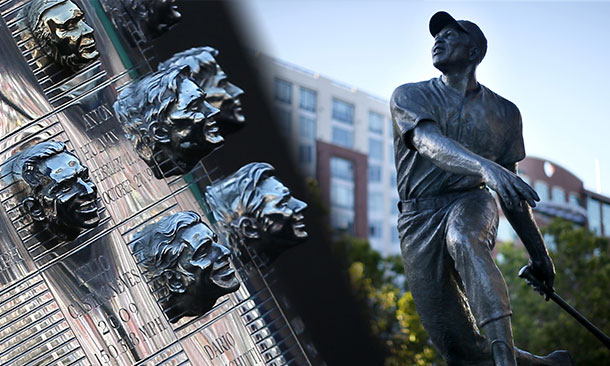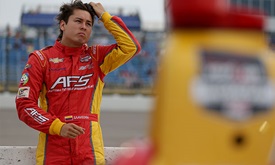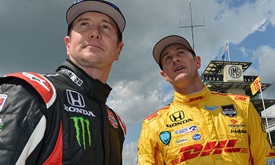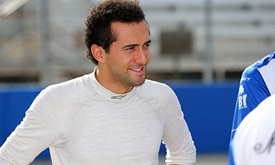How Borg-Warner Trophy connects to World Series
OCT 23, 2014
William Behrends is completing the bas relief image of 2014 Indianapolis 500 Mile Race winner Ryan Hunter-Reay, which will be affixed to the Borg-Warner Trophy and unveiled in December at the Indianapolis Motor Speedway Hall of Fame Museum.
Behrends, who has created the iconic sterling silver images of the 500 Mile Race winners since 1990, is acclaimed for the detail and how he captures actions and traits familiar to the character, and that is where the Borg-Warner Trophy representing "The Greatest Spectacle in Racing" intersects with baseball's World Series.
Behrends created the four sculptures dedicated to San Francisco Giants all-time greats – Willie Mays (dedicated on March 31, 2000, just before the opening of the park), Willie McCovey (dedicated in 2003), Juan Marichal (dedicated in 2005) and Orlando Cepeda (dedicated in 2008). All four of their numbers have been retired by the team.
The best-of-seven World Series moves to San Francisco for a three-game weekend set with the Giants and Kansas City Royals tied at 1, and shots of the Mays statue located in front of the main ballpark entrance at 24 Willie Mays Plaza will undoubtedly be part of the FOX telecast.
“I am very fortunate and I feel honored to be part of the Indianapolis 500 and the World Series,” Behrends said. “They are two American institutions in sports and I’m very much a sports fan – a racing fan and a baseball fan so they are very special to me."
The 9-foot-tall statue of Mays on a 5-foot-tall marble base is surrounded by 24 palm trees in honor of his No. 24 jersey. It was commissioned by Giants Managing Partner Peter Magowan to merge the franchise’s history with its new home.
“This was the one they envisioned being in front of the ballpark,” Behrends said. “In fact, when I first went out there they were just beginning construction and pointed to where they planned for the main entrance and sculpture. I wish I had a concession for the number of photos taken in front of that statue.”
Mays, 83, of Westfield, Ala., was elected to the Baseball Hall of Fame in 1979 after a career with the New York and San Francisco Giants and New York Mets that included a .302 career batting average, 3,283 hits, 660 home runs and 1,903 RBI.
“I grew up watching baseball at Wrigley Field and remember seeing him play,” said Behrends, a Wisconsin native. “When I was playing Little League Baseball, my stance was Willie Mays all the way. He was one of my childhood heroes, so to be considered for this was an honor.
“The first time I went out (to the site of the ballpark) I made a couple of clay models of what I envisioned the statue to be. Peter and I went to Willie’s house and we talked baseball and I took some photos. I got to interact with him and got to know him as a person and spent some time with him at spring training, too.
“Peter and I discussed what the statue should be because Willie was really a player who could do it all so how do you condense that into one image? The idea was to depict him right after contact and leaning toward first base to not only show his hitting but his prowess on the basepaths, as an athlete. A sculpture like that, unlike a painting or two-dimensional piece, is something that is to be viewed from 360 degrees. So how do you make something interesting all around? That piece does that because he’s twisting and turning and moving.”
Behrends also created the statue of Hall of Famer Tony Gwynn that resides at the San Diego Padres’ ballpark and the one at MCU Park in Brooklyn, N.Y., inspired by the friendship of Brooklyn Dodgers teammates Jackie Robinson and Pee Wee Reese, helped advance integration in Major League Baseball.
Behrends was as attentive to detail as was Gwynn about his hitting. He consulted extensively with Gwynn as he developed his clay models in his North Carolina studio, studying photographs and videos for iconic poses and nuances: Gwynn's batting glove, his sweatbands, the wrinkles in his uniform, the wrist guard he kept in his left back pocket when he was hitting. To simulate the size and strength of Gwynn's legs, Behrends hired as his model a local shot putter.
“It’s that moment of contact because he was a contact hitter,” Behrends said. “I studied his swing a good bit, and he and I spent the day together talking baseball and things he learned from Ted Williams. That helped me a lot. After that, it’s a lot of technical stuff of me learning the nuances of his swing.”
Behrends laughed when told that Gwynn was initially apprehensive that the sculpture would capture his persona: “I've done bobbleheads and I saw how those turned out. I have yet to see a bobblehead that looks like me,” said Gwynn, who passed away this year.
“I think he was pleased with the sculpture,” Behrends said.



















